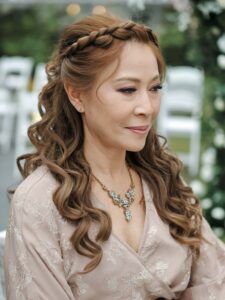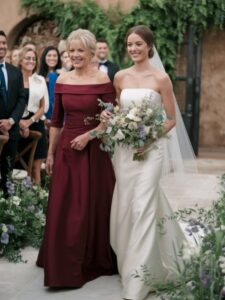The role of the mother of the groom has evolved with modern weddings.
Offering more flexibility and opportunities for involvement.
Her support and presence can make a meaningful difference.
Helping her son and his partner feel loved and supported as they begin this new chapter.
Whether stepping in for planning or simply offering a steady presence, the mother of the groom plays a cherished and valuable role in the celebration.
Traditional Roles of the Mother of the Groom in a Modern Wedding
1. Hosting the Rehearsal Dinner
Traditionally, the groom’s family hosts the rehearsal dinner.
Today, while this expectation is still common, there’s more flexibility in how it’s approached.
Whether taking on full planning or simply helping coordinate, hosting the dinner allows the mother of the groom to create a memorable, intimate gathering before the big day.
To make the evening truly special, coordinating closely with both partners is essential.
Their preferences should shape the style of the event, whether it’s a cozy, casual dinner or a themed celebration.
Adding a personal touch, such as a welcoming toast or a few heartfelt words about the couple, can make the night memorable.
Some mothers even create a short video or slideshow celebrating the couple’s journey, adding a sentimental element to the celebration.
2. Support for the Groom
Providing emotional support for the groom is a timeless role, though in modern weddings, this support may take different forms.
In the case of two grooms, both mothers (or other significant figures) might share in this role, creating a circle of support that brings both families closer.
Supporting the groom today often means being a steady source of encouragement during the planning period.
Whether through a weekly check-in, planning a casual “date” to catch up, or simply offering advice when he’s feeling the pressure, a calm, positive presence goes a long way.
At the same time, respecting the couple’s choices and boundaries shows understanding and adaptability, especially since many modern couples take charge of decisions themselves.
3. Gifting the Couple
A gift from the groom’s family is a meaningful tradition, often symbolizing the union of two families.
Modern mothers of the groom, however, are expanding what “gift” means, opting for presents that feel personal and reflective of the couple’s values and personalities.
Some may choose to gift an heirloom with special meaning, such as a piece of jewelry, a family portrait, or custom artwork that represents the couple’s journey.
Experience-based gifts are also popular, especially for couples who value shared moments over material items.
A planned getaway, spa day, or gourmet class can serve as a lasting reminder of their new adventure together.
Many mothers find that a heartfelt letter or a video message adds a truly personal and touching element—often one of the most treasured parts of the gift.
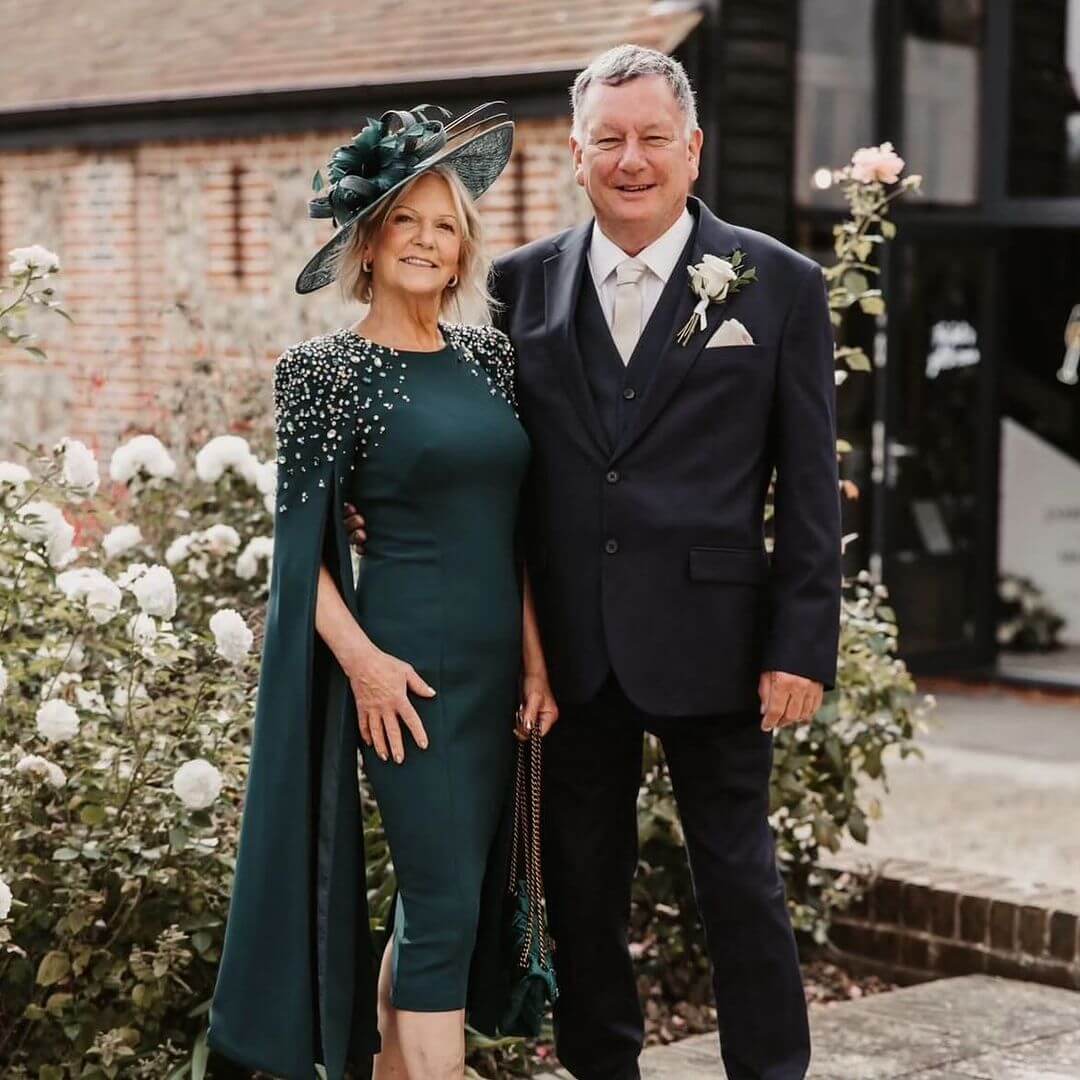
Planning Contributions and Etiquette
The mother of the groom’s role in wedding planning is evolving, and knowing how involved to be—and where to set boundaries—can create a supportive, harmonious experience.
While some mothers prefer to take an active role, others take a step back, allowing the couple to lead.
The key is to balance involvement with respect for the couple’s vision.
Understanding the couple’s wishes upfront helps to define a supportive role without overstepping.
Open conversations early in the planning process are valuable. This is an opportunity for the mother to offer help in specific areas—whether coordinating family members or assisting with tasks like setting up a guest list for the groom’s side.
It’s essential, however, to keep this involvement flexible.
Be ready to step back if the couple prefers a more hands-on approach themselves.
Staying connected and available, but without pressing for details or influencing decisions, ensures the couple feels empowered and supported.
Financial Contributions
Traditionally, the groom’s family would contribute financially to parts of the wedding, often covering the rehearsal dinner.
However, as modern weddings have become more flexible in terms of cost-sharing, financial roles are no longer as clear-cut.
Today, some families split expenses equally, while others choose to contribute based on their resources and comfort level.
Discussing financial contributions openly and early can prevent misunderstandings and ensure clarity.
If the groom’s family is covering the rehearsal dinner, the mother of the groom can work with the couple to determine a reasonable budget that aligns with their vision.
For families interested in helping beyond traditional roles, it’s common to contribute to wedding costs or give a meaningful financial gift to the couple to use as they see fit.
Respecting the couple’s preferences and offering financial support as a gesture rather than an expectation helps maintain a modern, supportive approach.
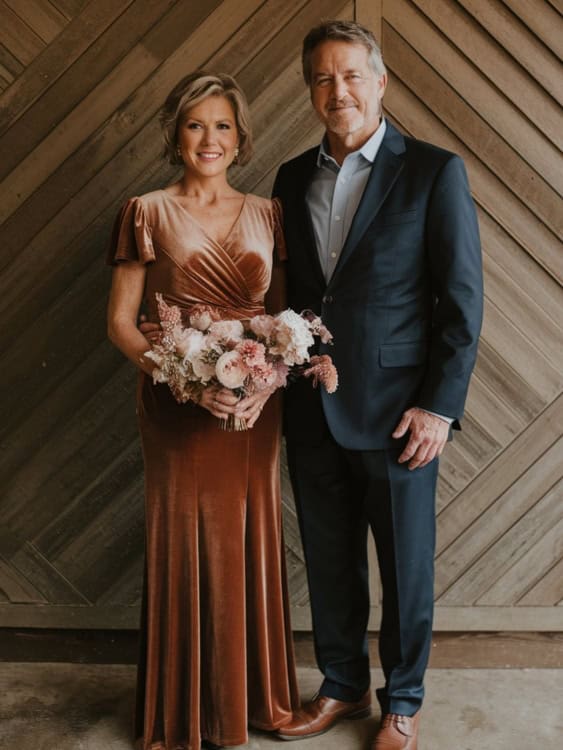
Groom-Focused Responsibilities
For the mother of the groom, supporting her son directly through thoughtful, groom-focused responsibilities can make the wedding experience even more meaningful.
Whether helping with attire, coordinating family logistics, or planning personal moments together.
These roles allow her to stay connected to her son’s big day in a way that feels natural and supportive.
Helping with Groom’s Attire
One of the most enjoyable roles for a mother of the groom can be helping him select his wedding attire or choosing accessories that add a personal touch.
This is an opportunity to offer both style advice and sentimental input, especially if incorporating family traditions. If there’s a family heirloom, like a tie pin, cufflinks, or watch, she can suggest these pieces as part of his wedding-day look.
Even if the groom has a strong sense of style, having his mother’s perspective can provide a special connection, making this part of the planning uniquely memorable.
Coordinating the Groom’s Side of the Family
With guests from the groom’s side attending, the mother often takes on a coordinating role.
Ensuring family members are informed of key details like travel arrangements, hotel blocks, and the wedding-day timeline.
She can assist with seating arrangements, family photos, or any logistics involving extended family, helping everyone feel involved and valued.
On the wedding day, her familiarity with family dynamics makes her a natural choice for managing group photos, guiding guests, or addressing any last-minute needs.
Planning Groom-Specific Events
Many mothers of the groom cherish the chance to spend one-on-one time with their son before the big day, creating special pre-wedding memories.
This could mean organizing a casual brunch, going out for a shared activity they enjoy, or simply setting aside a quiet moment together.
In weddings with two grooms, both mothers (or key family figures) can create similar moments, celebrating each groom’s journey with a personal touch.
These events are small yet meaningful, marking the milestone with a sense of togetherness and celebration.
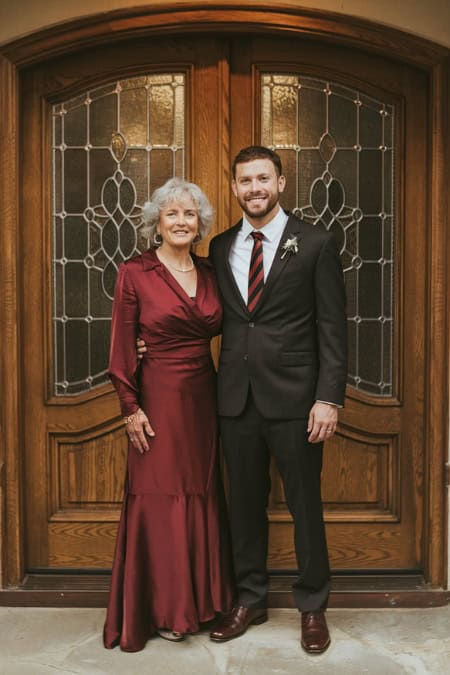
On the Day Roles for the mother of the groom
Getting Ready and Pre-Ceremony Support
On the wedding morning, the mother of the groom can join him as he prepares, assisting with final touches like adjusting his tie, pinning his boutonniere, or simply offering a few calming words.
If there’s a family heirloom—such as cufflinks, a watch, or a letter—this is a meaningful moment to present it.
She may also join him for pre-ceremony photos, creating keepsake images of this special time together.
It has become more common for the mother of the groom to join the bride while getting ready also. Speak with couple and see what is right for them and you.
Special Duties During the Ceremony
Depending on the couple’s wishes, the mother of the groom might have a symbolic role in the ceremony, such as joining in a unity ritual or offering a family blessing.
These gestures honor family connections and bring a personal touch to the event.
Reception and Social Roles
At the reception, she can play a welcoming role, greeting guests and particularly family friends, helping the groom’s side feel included and comfortable.
This is a chance to bridge both families, fostering a warm, inclusive atmosphere.
Mother-Son Dance
The mother-son dance is a treasured moment that reflects their bond.
Choosing a meaningful song together adds personal significance, making this shared dance a memorable highlight of the day.
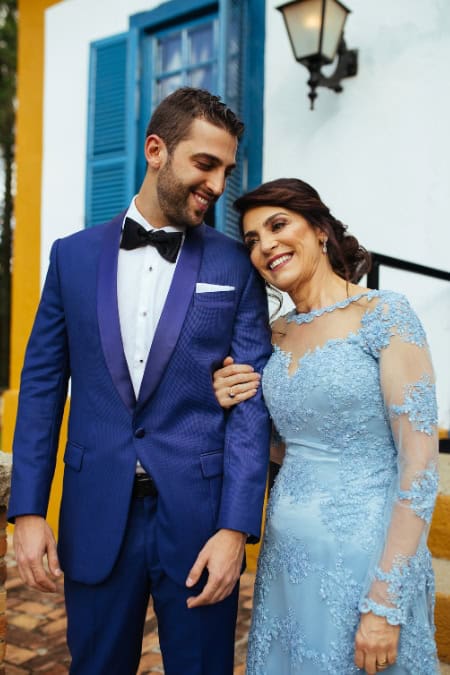
Tips for a Positive Relationship with the Bride’s (or Groom’s) Family
Building a positive relationship with their family can enhance the entire wedding experience.
Early communication is key; reaching out ahead of major events fosters goodwill and sets a warm tone.
A friendly, supportive attitude, paired with genuine interest in getting to know them, helps prevent misunderstandings and creates a foundation of mutual respect.
Offering help when needed and staying flexible about each family’s traditions or preferences further strengthens these bonds, contributing to a harmonious celebration for both families.
More blogs you will love!
- The Complete Mother’s Wedding Checklist (Free Printable)
- Mother of the Bride Style Checklist (Free Printable) – Your Complete Wedding Day Style Guide
- Shoulder-Length Wedding Hairstyles Perfect for Mothers of the Bride and Groom
- How to Wear Your Hair Down as the Mother of the Bride: 15 Beautiful Ideas
- 20+ Elegant Half-Up Hairstyles for Mothers of the Bride
- 26 mother of the bride (& Groom) Medium Length Hairstyle ideas
- Winter Mother of the Bride Dresses and Outfits: warm and stylish
- Letter to Daughter-in-Law on Wedding Day, with examples
- Letter to Son on Wedding Day Fulle guide & examples






